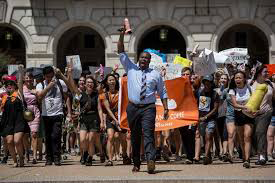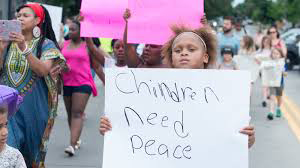 Special to the Philanthropy Journal
Special to the Philanthropy Journal
By Susan Danish
It’s no secret that cities from Charleston to Orlando to Baton Rouge to Dallas to Baltimore have faced civil unrest, racially motivated violence and hate crimes at an alarming rate in recent months and years. As Allie Chang Ray, who was President of the Junior League of St. Louis after the police shooting of Michael Brown in nearby Ferguson, said: “Civil unrest is something that we should all be thinking about, because this could happen in any city.” Frankly, the “it can’t happen here” notion has been history since 9/11.
![]() At The Junior League, we believe that the need for community-based nonprofits to take a leadership role during times of civic trauma has never been greater. But that task is challenging precisely because it requires not just connecting to communities when they are affected by crisis but also in ongoing community collaboration on problems that are rightly seen as larger than any one organization.
At The Junior League, we believe that the need for community-based nonprofits to take a leadership role during times of civic trauma has never been greater. But that task is challenging precisely because it requires not just connecting to communities when they are affected by crisis but also in ongoing community collaboration on problems that are rightly seen as larger than any one organization.
That’s what The Association of Junior Leagues International, Inc (AJLI) discovered as we decided proactively to discern what Junior Leagues are doing to participate in addressing crisis events in their own communities. As an association representing nearly 300 independent Junior Leagues, AJLI was able to initiate an important conversation on a broad basis by sharing the knowledge from our League leaders who were on the ground. Our efforts have continued with “town hall” formatted webinars to provide an opportunity for further conversation and with more in-person sessions – including one later this Fall, in the aftermath of Orlando, Baton Rouge, Falcon Heights and Dallas.
Here’s what we learned from speaking with Junior League leaders who have been faced with engaging with their communities in the aftermath of civic trauma.
 First, recognize that everyone in your leadership team will be under enormous psychological and emotional strain due to the stressful and tense environment. This means being flexible with your organization’s plans and being willing to shift gears, so that both leadership, volunteers or membership can engage actively with the issues at hand.
First, recognize that everyone in your leadership team will be under enormous psychological and emotional strain due to the stressful and tense environment. This means being flexible with your organization’s plans and being willing to shift gears, so that both leadership, volunteers or membership can engage actively with the issues at hand.
Second, commit to effective internal, organizational communications from the start of the crisis. Find out if members/staff/volunteers (or their families) have been directly impacted by events – you would be surprised at the connections. Also ask members and volunteers for their own ideas on how to respond as the situation evolves. (Junior Leagues range in size from under 100 to over 5,000 members, each one with relevant knowledge, contacts, updates, ideas, experience and skills.)
Effective communications also are important in dealing with one of the challenges Junior Leagues, and I am sure many organizations, face in developing a crisis response: as diverse organizations, there will be divergent views on what, if anything, the organization can or should do publicly. At the very least, modeling what it is like to be the place where divergent views can be discussed and heard is a positive step in these challenging times.
Third, don’t work in a vacuum. Contact your community partners and other organizations with ties to the affected community—churches, youth centers or community centers. They may request immediate assistance with collection drives for supplies to meet basic needs or in spreading the word about how to access services. Also take the opportunity to reach out to organizations you don’t already work with.
After the unrest in Ferguson, for example, the Junior League of St. Louis identified that the residents living in the immediate community were afraid to go outside and were in dire need of basic supplies, from diapers to food. The League partnered with local churches to deliver them.
 Following the death of Freddie Gray in the custody of Baltimore police, the Junior League of Baltimore organized a number of community outreach initiatives, including gathering toys and supplies for a new community center in the affected area, which became a “safe zone” for children there. But the League also used the aftermath of the initial events to begin to rebuild its profile in the city that is representative of its diverse membership. Cylia Lowe-Smith, who was League President at the time, said, “We had a long, rich history of social activism, community involvement, and were, for many years, the go-to organization in our community to get things done and to be considered players or to have a seat at the table, but somehow we lost that along the way.” This was a critical moment for The Junior League to redefine its role and commitment to the community.
Following the death of Freddie Gray in the custody of Baltimore police, the Junior League of Baltimore organized a number of community outreach initiatives, including gathering toys and supplies for a new community center in the affected area, which became a “safe zone” for children there. But the League also used the aftermath of the initial events to begin to rebuild its profile in the city that is representative of its diverse membership. Cylia Lowe-Smith, who was League President at the time, said, “We had a long, rich history of social activism, community involvement, and were, for many years, the go-to organization in our community to get things done and to be considered players or to have a seat at the table, but somehow we lost that along the way.” This was a critical moment for The Junior League to redefine its role and commitment to the community.
After the shooting in Charleston that left nine African American church members dead at the hands of an apparent white supremacist, “We had a community that really showed love in order to combat this hate crime,” said Dorothy Thaxton, President of the Junior League of Charleston at the time, “and we had to decide how the Junior League was going to get involved.” In addition to quickly making a grant in support of the victims’ families, the League became more purposeful by developing social, cultural and inclusion training for its members while exploring Charleston’s racial history.
As with natural disasters, staying involved after the immediate need (and the media) goes away is vital. That’s why the St. Louis League, after assessing a report from The Ferguson Commission, identified economic mobility as a way it might start to address the community’s underlying issues and began advocating for policy changes on issues that disproportionately affect African-American families.
Susan Danish brings more than 20 years of experience in business and nonprofit leadership to her role as Executive Director of The Association of Junior Leagues International, Inc.




